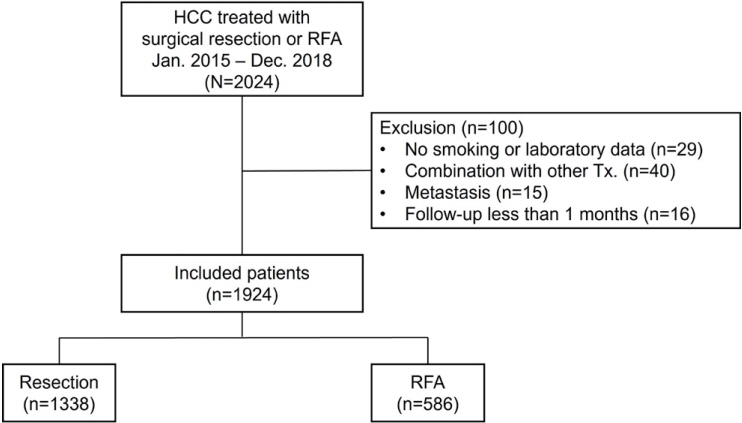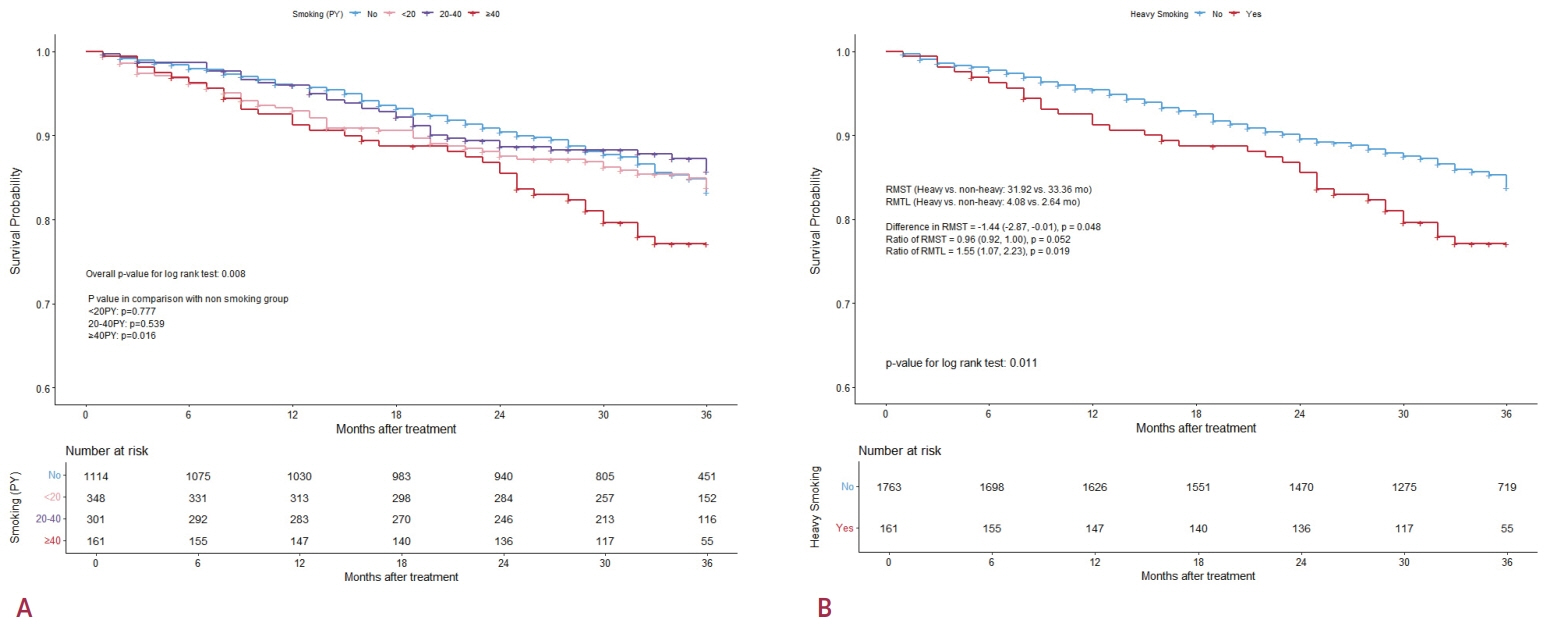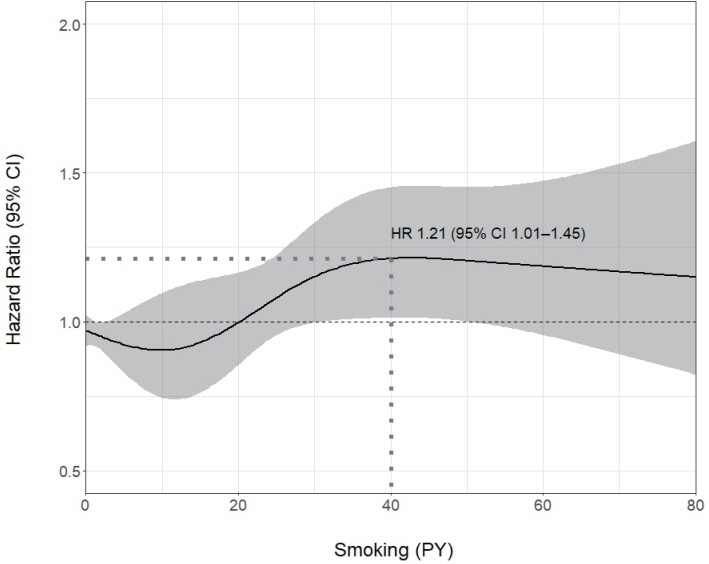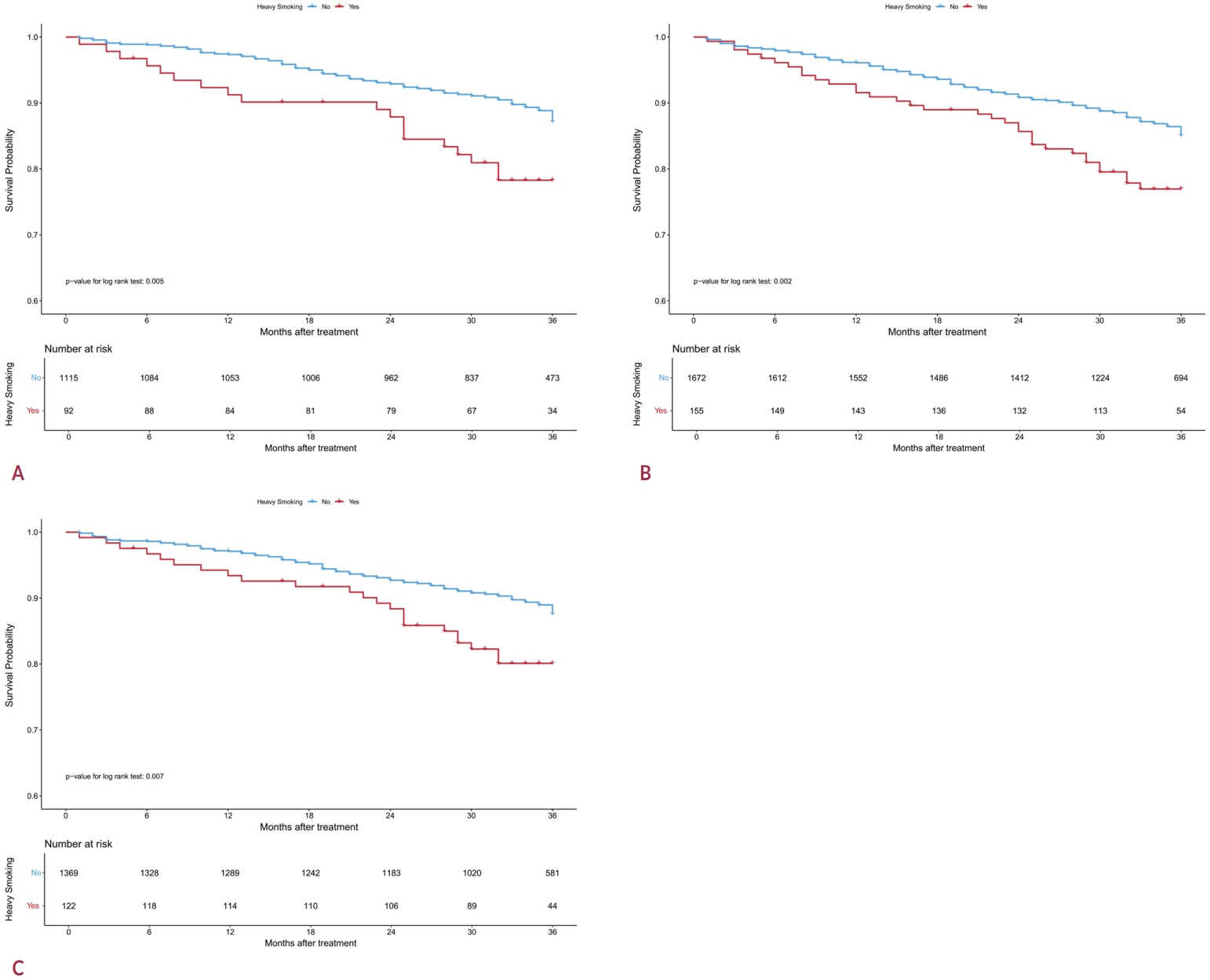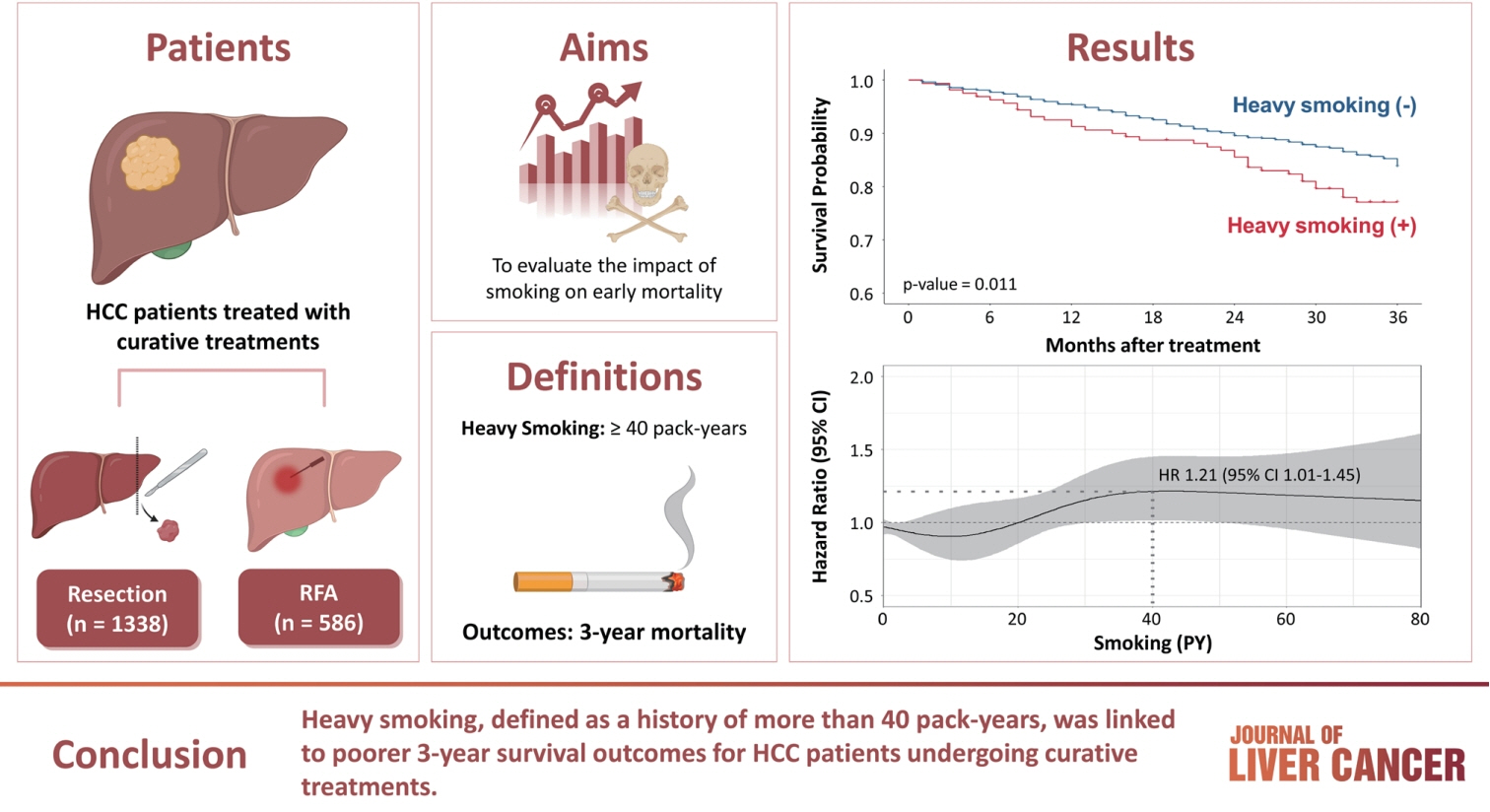J Liver Cancer.
2024 Sep;24(2):253-262. 10.17998/jlc.2024.06.02.
Heavy smoking increases early mortality risk in patients with hepatocellular carcinoma after curative treatment
- Affiliations
-
- 1The Catholic University Liver Research Center, College of Medicine, The Catholic University of Korea, Seoul, Korea
- 2Division of Gastroenterology, Department of Internal Medicine, Seoul St. Mary’s Hospital, College of Medicine, The Catholic University of Korea, Seoul, Korea
- 3Division of Gastroenterology, Department of Internal Medicine, Incheon St. Mary’s Hospital, College of Medicine, The Catholic University of Korea, Seoul, Korea
- KMID: 2559472
- DOI: http://doi.org/10.17998/jlc.2024.06.02
Abstract
- Backgrounds/Aims
Although cigarette smoking has been associated with an increased risk of hepatocellular carcinoma (HCC), its association with HCC mortality remains underexplored. We aimed to evaluate the effect of smoking on early mortality in HCC patients following curative treatment.
Methods
Data from the Korean Primary Liver Cancer Registry were examined for HCC patients who underwent liver resection or radiofrequency ablation between 2015 and 2018. Smoking cumulative dose was assessed in pack-years. The primary outcome was the 3-year overall survival (OS).
Results
Among 1,924 patients, 161 were classified as heavy smokers (≥40 pack-years). Heavy smokers exhibited a lower 3-year survival rate (77.1%) than nonsmokers (83.3%), with a significant difference observed in the 3-year OS (P=0.016). The assessment of smoking pack-years in relation to 3-year OS revealed a dose-dependent pattern, with the hazard ratio exceeding 1.0 at 20 pack-years and continuing to rise until 40 pack-years, reaching peak at 1.21 (95% confidence interval, 1.01-1.45). Multivariate Cox-regression analysis revealed heavy smoking, age ≥60 years, underlying cirrhosis, tumor size >3 cm, vascular invasion, and Child-Pugh class B/C as risk factors for 3-year OS. Subgroup analyses of patients with a tumor size <3 cm, absence of vascular invasion, and meeting the Milan criteria also showed inferior outcomes for heavy smokers in all three subgroups.
Conclusions
Heavy smoking, defined as a history of >40 pack-years, was linked to poorer 3-year survival outcomes in HCC patients undergoing curative treatments, underscoring the importance of smoking cessation in this population.
Figure
Reference
-
References
1. Sung H, Ferlay J, Siegel RL, Laversanne M, Soerjomataram I, Jemal A, et al. Global cancer statistics 2020: GLOBOCAN estimates of incidence and mortality worldwide for 36 cancers in 185 countries. CA Cancer J Clin. 2021; 71:209–249.
Article2. Girardi DM, Sousa LP, Miranda TA, Haum FNC, Pereira GCB, Pereira AAL. Systemic therapy for advanced hepatocellular carcinoma: current stand and perspectives. Cancers (Basel). 2023; 15:1680.3. Cho Y, Kim BH, Park JW. Overview of Asian clinical practice guidelines for the management of hepatocellular carcinoma: an Asian perspective comparison. Clin Mol Hepatol. 2023; 29:252–262.
Article4. Korean Liver Cancer Association (KLCA); National Cancer Center (NCC) Korea. 2022 KLCA-NCC Korea practice guidelines for the management of hepatocellular carcinoma. Clin Mol Hepatol. 2022; 28:583–705.5. Yoon JH, Choi SK. Management of early-stage hepatocellular carcinoma: challenges and strategies for optimal outcomes. J Liver Cancer. 2023; 23:300–315.
Article6. Lee M, Chang Y, Oh S, Cho YY, Jung DE, Kim HH, et al. Assessment of the surveillance interval at 1 year after curative treatment in hepatocellular carcinoma: risk stratification. Gut Liver. 2018; 12:571–582.
Article7. Singal AG, Zhang E, Narasimman M, Rich NE, Waljee AK, Hoshida Y, et al. HCC surveillance improves early detection, curative treatment receipt, and survival in patients with cirrhosis: a meta-analysis. J Hepatol. 2022; 77:128–139.
Article8. Kuo MJ, Mo LR, Chen CL. Factors predicting long-term outcomes of early-stage hepatocellular carcinoma after primary curative treatment: the role of surgical or nonsurgical methods. BMC Cancer. 2021; 21:250.9. Ahn YH, Lee H, Kim DY, Lee HW, Yu SJ, Cho YY, et al. Independent risk factors for hepatocellular carcinoma recurrence after directacting antiviral therapy in patients with chronic hepatitis C. Gut Liver. 2021; 15:410–419.
Article10. Saeed U, Nordsletten M, Myklebust TÅ, Robsahm TE, Møller B, Skålhegg BS, et al. Cancer risk and survival according to body mass index in hepatobiliary malignancies: a nationwide registry-based cohort study. HPB (Oxford). 2023; 25:1382–1392.
Article11. Shirai D, Shinkawa H, Takemura S, Tanaka S, Amano R, Kimura K, et al. Impact of alcohol abstinence on survival after hepatic resection for hepatocellular carcinoma in patients with alcohol-related liver disease. Ann Med Surg (Lond). 2021; 68:102644.
Article12. Yang SY, Yan ML, Feng JK, Duan YF, Ye JZ, Liu ZH, et al. Impact of type 2 diabetes mellitus on the prognosis of patients with hepatocellular carcinoma after laparoscopic liver resection: a multicenter retrospective study. Front Oncol. 2022; 12:979434.
Article13. Petrick JL, Campbell PT, Koshiol J, Thistle JE, Andreotti G, Beane-Freeman LE, et al. Tobacco, alcohol use and risk of hepatocellular carcinoma and intrahepatic cholangiocarcinoma: the liver cancer pooling project. Br J Cancer. 2018; 118:1005–1012.14. Yoo JJ, Park MY, Cho EJ, Yu SJ, Kim SG, Kim YJ, et al. Smoking increases the risk of hepatocellular carcinoma and cardiovascular disease in patients with metabolic-associated fatty liver disease. J Clin Med. 2023; 12:3336.
Article15. Kolly P, Knöpfli M, Dufour JF. Effect of smoking on survival of patients with hepatocellular carcinoma. Liver Int. 2017; 37:1682–1687.
Article16. Abdel-Rahman O, Helbling D, Schöb O, Eltobgy M, Mohamed H, Schmidt J, et al. Cigarette smoking as a risk factor for the development of and mortality from hepatocellular carcinoma: an updated systematic review of 81 epidemiological studies. J Evid Based Med. 2017; 10:245–254.
Article17. Lv Y, Liu C, Wei T, Zhang JF, Liu XM, Zhang XF. Cigarette smoking increases risk of early morbidity after hepatic resection in patients with hepatocellular carcinoma. Eur J Surg Oncol. 2015; 41:513–519.
Article18. Siegel AB, Conner K, Wang S, Jacobson JS, Hershman DL, Hidalgo R, et al. Smoking and hepatocellular carcinoma mortality. Exp Ther Med. 2012; 3:124–128.19. Kim BH, Yun EH, Lee JH, Hong G, Park JY, Shim JH, et al. Advancing Korean nationwide registry for hepatocellular carcinoma: a systematic sampling approach utilizing the Korea Central Cancer Registry database. J Liver Cancer. 2024; 24:57–61.
Article20. Lee YH, Shin MH, Kweon SS, Choi JS, Rhee JA, Ahn HR, et al. Cumulative smoking exposure, duration of smoking cessation, and peripheral arterial disease in middle-aged and older Korean men. BMC Public Health. 2011; 11:94.
Article21. Ogawa K, Koh Y, Kaneda H, Izumi M, Matsumoto Y, Sawa K, et al. Can smoking duration alone replace pack-years to predict the risk of smoking-related oncogenic mutations in non-small cell lung cancer? A crosssectional study in Japan. BMJ Open. 2020; 10:e035615.
Article22. Gholami S, Perry LM, Denbo JW, Chavin K, Newell P, Ly Q, et al. Management of early hepatocellular carcinoma: results of the Delphi consensus process of the Americas Hepato-Pancreato-Biliary Association. HPB (Oxford). 2021; 23:753–761.
Article23. Chiang CH, Lu CW, Han HC, Hung SH, Lee YH, Yang KC, et al. The relationship of diabetes and smoking status to hepatocellular carcinoma mortality. Medicine (Baltimore). 2016; 95:e2699.24. Vardavas CI, Nikitara K. COVID-19 and smoking: a systematic review of the evidence. Tob Induc Dis. 2020; 18:20.
Article25. Fedeli U, Girardi P, Gardiman G, Zara D, Scoizzato L, Ballarin MN, et al. Mortality from liver angiosarcoma, hepatocellular carcinoma, and cirrhosis among vinyl chloride workers. Am J Ind Med. 2019; 62:14–20.
Article26. Chuang SC, Lee YC, Hashibe M, Dai M, Zheng T, Boffetta P. Interaction between cigarette smoking and hepatitis B and C virus infection on the risk of liver cancer: a meta-analysis. Cancer Epidemiol Biomarkers Prev. 2010; 19:1261–1268.
Article27. Wang YH, Chuang YH, Wu CF, Jan MC, Wu WJ, Lin CL, et al. Smoking and hepatitis B virus-related hepatocellular carcinoma risk: the mediating roles of viral load and alanine aminotransferase. Hepatology. 2019; 69:1412–1425.
Article28. Qiu F, Liang CL, Liu H, Zeng YQ, Hou S, Huang S, et al. Impacts of cigarette smoking on immune responsiveness: up and down or upside down? Oncotarget. 2017; 8:268–284.29. Jain D, Chaudhary P, Varshney N, Razzak KSB, Verma D, Zahra TRK, et al. Tobacco smoking and liver cancer risk: potential avenues for carcinogenesis. J Oncol. 2021; 2021:5905357.
Article30. Kõks G, Uudelepp ML, Limbach M, Peterson P, Reimann E, Kõks S. Smoking-induced expression of the GPR15 gene indicates its potential role in chronic inflammatory pathologies. Am J Pathol. 2015; 185:2898–2906.
Article31. Yamaguchi NH. Smoking, immunity, and DNA damage. Transl Lung Cancer Res. 2019; 8 Suppl 1:S3–S6.
Article32. Yu S, Jo HS, Yu YD, Choi YJ, Kim DS. Clinical outcome of surgical resection for multifocal T2-T3 hepatocellular carcinoma up to 3 nodules: a comparative analysis with a single nodule. J Liver Cancer. 2023; 23:377–388.
Article33. Yoon JS, Lee HA, Kim HY, Sinn DH, Lee DH, Hong SK, et al. Hepatocellular carcinoma in Korea: an analysis of the 2015 Korean nationwide cancer registry. J Liver Cancer. 2021; 21:58–68.34. A’Hern RP. Restricted mean survival time: an obligatory end point for time-to-event analysis in cancer trials? J Clin Oncol. 2016; 34:3474–3476.
Article
- Full Text Links
- Actions
-
Cited
- CITED
-
- Close
- Share
- Similar articles
-
- Who Needs Screening for the Early Detection of Hepatocellular Carcinoma ?
- Protrusion of hepatocellular carcinoma is a predictor of early recurrence in hepatectomy patients after spontaneous rupture
- Surgical Perspectives of Hepatocellular Carcinoma beyond the Barcelona Clinical Liver Cancer Guideline; Focusing on Liver Resection
- A Case of Long Term Survival in Patient with Early Intrahepatic Recurrence and Extrahepatic Metastasis after Curative Resection of Hepatocellular Carcinoma
- Curative Loco-regional Therapies for Early Hepatocellular Carcinoma: Is Combination Effective?

